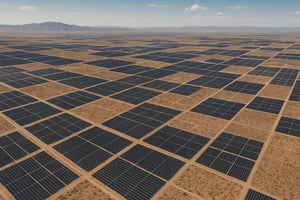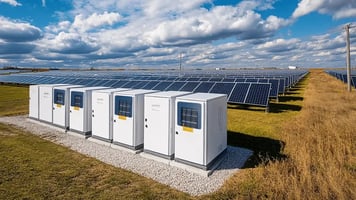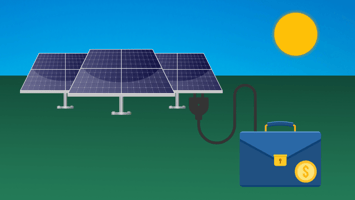Before discussing investment opportunities in utility-scale solar, I’ll provide some background and...
The Increasing U.S. Electricity Usage and Implications For Investing
After decades of relatively stagnant growth, the United States is experiencing an accelerated increase in power demand, with electricity usage predicted to grow 50% by 2040.
This increase is being driven by factors such as
- The rapid expansion of data centers (fueled by AI and cloud computing)
- The widespread adoption of electric vehicles (EVs)
- A resurgence in domestic manufacturing

For the past 20 years, US power consumption has increased less than 1% annually. However, over the next five years, it's expected to grow by almost 16%.
In July 2025, U.S. electricity peak demand set new records twice. The next decade will require more new electricity than any period in U.S. history.
This increased usage puts pressure on an underbuilt national power grid, raising concerns about grid reliability and the need for increased reliance on fossil fuels, particularly natural gas.
In addition, too much demand and an undersupply have been pushing up electricity prices at almost twice the rate of inflation.
Primary Drivers of Increased Electricity Usage
Several factors contribute to recent and anticipated increases in usage.
Data Centers (Traditional Cloud Computing Plus Artificial Intelligence)
As you may know, data centers are large, windowless buildings that house thousands of computer servers. There are almost 4,000 data centers in the fifty states. These centers operate continuously and require a significant amount of electricity. How much electricity?
Large data centers can use as much electricity at any given time as 800,000 homes.
The AI boom is a significant contributor to the growth of data centers. According to OpenAI CEO Sam Altman, OpenAI will likely spend trillions of dollars on data centers alone in the "not very distant future."
Even simple AI search queries consume about 10 times more power than a traditional Google search. Using LLMs for 'deep research' consumes even more power.

Video generation is quickly becoming a crucial entertainment and commercial AI use case, with AI filmmakers like PJ Accetturo creating viral AI-generated ads for a fraction of the cost of traditional advertising production.
However, every 5 seconds of generated video uses approximately 2.9 kilowatt-hours (kWh) of electricity, which is equivalent to running a microwave for an hour. Assuming an average of 5 re-generations per scene, a 45-second commercial or promotion uses about 130 kWh, enough to power several homes for a day.
Imagine the power consumption when entire streaming series and feature films are 100% AI-generated.
The above numbers are only estimates, as tech companies hold their cards close to the chest. This makes it difficult for researchers to accurately assess actual power needs.
Update: Google has released a technical paper detailing per-prompt electrical and water consumption. However, Google hasn't disclosed the total number of Gemini queries processed per day.
The Steady Growth of Electric Vehicles (EVs)
EVs have represented a significant shift in the automobile industry, driven by environmental concerns and lower operating costs.
However, as more EVs are adopted by consumers and businesses, the demand for electricity and its distribution will increase. This will strain the existing grid, which was not designed to handle the load from millions of electric vehicles.

A National Electrical Manufacturers Association (NEMA) study forecasts a 9000% increase in e-mobility power consumption through 2050, with the highest regional impact in the Northeast and West.
Domestic Manufacturing Growth
A resurgence in U.S. manufacturing, partly driven by tariffs, is another key factor contributing to increased electricity needs.The U.S. EIA forecasts industrial electricity sales to grow 2.0 percent in 2025 and 3.5 percent in 2026.
A recent example of expanding manufacturing activity is GE Appliances' $3 billion investment to reshore production of appliances (refrigerators, washers, ranges, and water heaters) across several states. This will substantially increase power consumption in these manufacturing plants.
On the topic of appliances, states such as California require electric-only appliances in new homes and buildings to reduce harmful emissions from natural gas appliances.
Industries that consume large amounts of power include semiconductor and battery manufacturing facilities, data centers (as referenced above), and traditional heavy industries such as chemicals, petroleum processing, mining, and paper production.
Potential Solutions and the Path Forward
Several of the solutions are investment opportunities for family offices and accredited investors.
Scaling Up Renewable Energy: There is a need to quickly scale up renewable energy, not only for data centers but for all energy needs. Experts advocate for 'all of the above' solutions: wind power, solar energy, energy storage, and nuclear.
- Energy Storage: Battery storage is crucial for a reliable grid. Batteries can store excess electricity generated from renewables for use during periods of peak demand. This smooths out fluctuations in electricity supply and demand.
- Transparency from Tech Companies: Researchers suggest that the best place to start is to require more transparency from these tech companies regarding their energy usage for AI. This is critical for planning purposes.
- Grid Modernization: Significant upgrades are necessary to support increasing demand from data centers, EVs, and manufacturing facilities. Investments in grid modernization and expansion are necessary.
- Smart Grid Technologies: These technologies can optimize grid operations and improve efficiency. They can enhance grid resilience by detecting and isolating faults.
- Policy and Regulatory Reforms: Permitting and Siting Reform - This includes generation, transmission, distribution, and development of critical minerals.
- Tax Incentive Predictability: Incentives for grid technologies and domestic manufacturing of critical infrastructure.
- Greater Collaboration: Utilities, policy makers, manufacturers, and consumers must work together to address these challenges.
The increase in U.S. electricity demand, primarily driven by data centers, the ongoing adoption of electric vehicles, and a rise in domestic manufacturing, represents a critical juncture for the nation's energy future.
While these factors present economic opportunities, they also pose challenges to grid reliability and the climate goals of many.
A comprehensive and expedited approach is required, focusing on expansion of all energy sources, most particularly rapidly deployed renewable energy sources, investment in energy storage and smart grid technologies, and streamlining of permitting and regulatory processes.
Without these coordinated efforts and new investments, the US risks falling short of its climate commitments and facing an unstable energy supply in the coming decades.
To discuss investment opportunities driven by increasing U.S. energy use, please set up a time:
Charles Schaffer
President and Founder, Accredica
Charles has founded and operated several development companies over his 35+ year history to pursue his passion for Alternative Investing. He believes outsized returns can be achieved without a corresponding increase in risk. Under Charles's leadership, Accredica has developed and financed over $160 million of commercial real estate and renewable energy projects.




